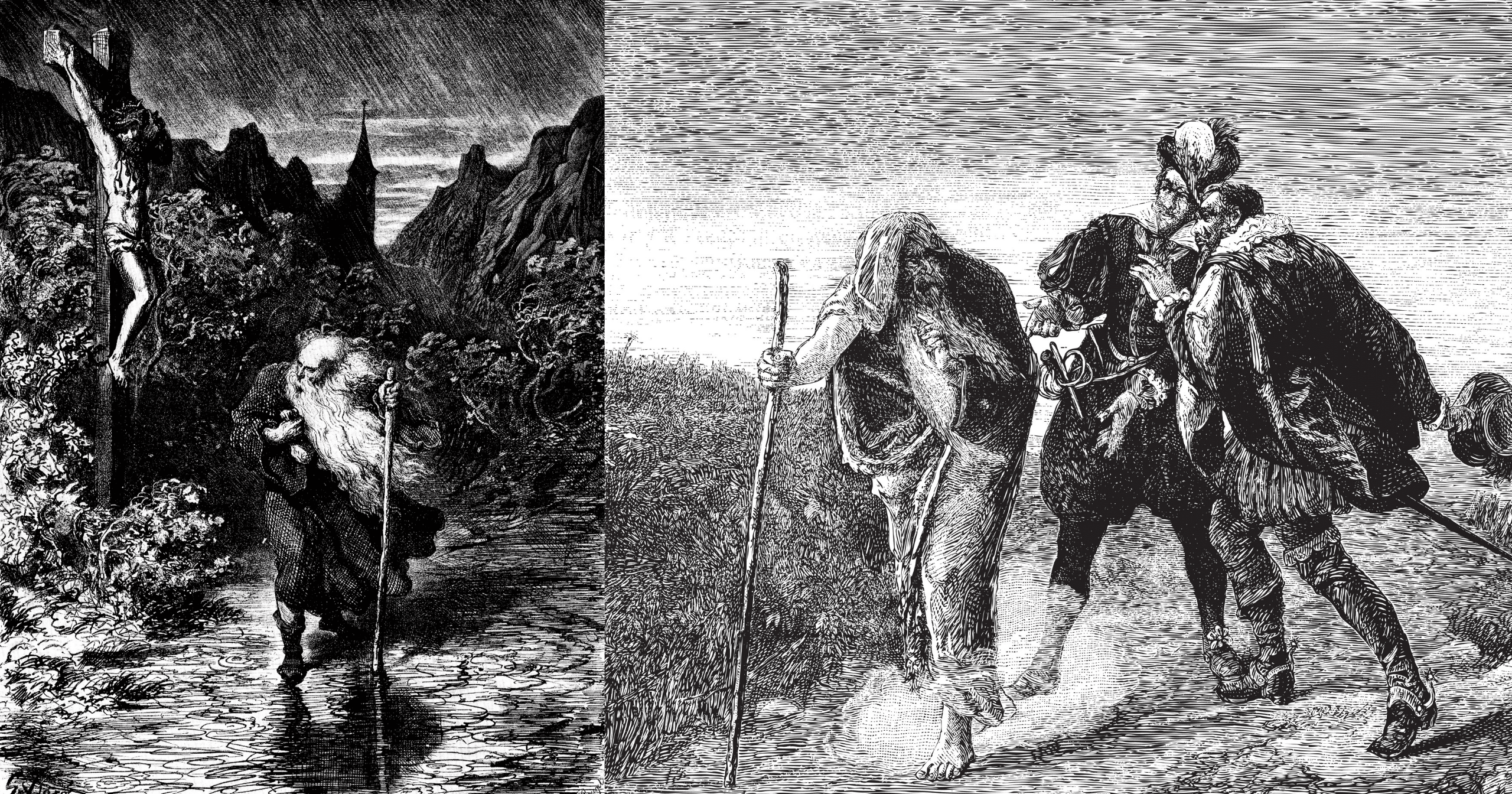The Wandering Jews is a figure from pious Christian legend going back to the earliest days of the Church.
The man is said to have taunted or otherwise committed an indiscretion towards Jesus on His way to the Crucifixion, and for it was cursed to walk the Earth until the Second Coming in a similar fashion to Cain.
The exact origin of the legend is unknown, with some historians believing it’s origin stems from Jesus’ words in Matthew or Hosea.
“Amen, I say to you, there are some standing here who will not taste death until they see the Son of Man coming in his kingdom.” – Matthew 16:28
“My God will disown them because they have not listened to him; they will be wanderers among the nations.” – Hosea 9:17
Early Christian texts make reference to the figure as well. In the early 7th century, Byzantine monk John Moschus writes of man who struck Christ and is punished to wander in eternal suffering:
I saw an Ethiopian, clad in rags, who said to me, “You and I are condemned to the same punishment.” I said to him, “Who are you?” And the Ethiopian who had appeared to me replied, “I am he who struck on the cheek the creator of the universe, our Lord Jesus Christ, at the time of the Passion. That is why,” said Isidor, “I cannot stop weeping.”
The legend took hold in the 12th century during the Medieval period, likely a product of the Crusades. The first ever written account of the Wandering Jew comes from a Bolognese Latin chronicle in 1223, where a group of pilgrims describe meeting “a certain Jew in Armenia.”
“Present at the Passion of the Lord and, as He was going to His martyrdom, drove Him along wickedly with these words : “Go, go, thou tempter and seducer, to receive what you have earned.” The Lord is said to have answered him: “I go, and you will await me till I come again.” This Jew is said, every hundred years, to be made young to the age of thirty, and he cannot die until the Lord returns.”
A fuller account comes five years later, written by English chronicler Roger of Wendover at the monastery of Saint Alban in his “Flowers of History.”
“When therefore the Jews were dragging Jesus forth, and had reached the door, Cartaphilus, a porter of the hall in Pilate’s service, as Jesus was going out of the door, impiously struck Him on the back with his hand, and said in mockery: ‘Go quicker, Jesus, go quicker; why do you loiter?’ And Jesus looking back on him with a severe countenance said to him, ‘I am going, and you will wait till I return.’ “And according as our Lord said, this Cartaphilus is still awaiting His return; at the time of our Lord’s Passion he was 30 years old; and when he attains the age of 100 years, he always returns to the same age as when our Lord suffered. After Christ’s death, when the Catholic faith gained ground, this Cartaphilus was baptized by Ananias (who also baptized the apostle Paul), and was called Joseph. He often dwells in both divisions of Armenia, and other eastern countries, passing his time amidst the bishops and other prelates of the Church; he is a man of holy conversation and religious, a man of few words and circumspect in his behavior, for he does not speak at all unless when questioned by the bishops and religious men; and then he tells of the events of old times, and of the events which occurred at the suffering and resurrection of our Lord, and of the witnesses of the Resurrection, namely those who rose with Christ, and went into the holy city, and appeared unto men; he also tells of the creed of the apostles, and of their separation and conversation; and all this he relates without smiling or levity of countenance, as one who is well practised in sorrow and the fear of God, always looking forward with fear to the coming of Jesus Christ, lest at the Last Judgment he should find Him in anger, whom, on His way to death, he had provoked to just vengeance. Numbers come to him from different parts of the world, enjoying his society and conversation; and to them, if they are men of authority, he explains all doubts on the matter on which he is questioned. He refuses all gifts that are offered to him, being content with slight food and clothing. He places his hope of salvation on the fact that he sinned through ignorance, for the Lord, when suffering, prayed for His enemies in these words, ‘Father, forgive them, for they know not what they do.'”
Throughout the rest of the Middle Ages and even into the late 19th century there were claims of sightings of the Wandering Jew.
There afterwards, the figure became subject of many plays, poems, novels, and other artistic works.
The legend was so prominent in the zeitgeist plants were even named after it: Tradescantia zebrina and Tradescantia fluminensis are perennial creeping plants known for their use as a houseplant and groundcover.















I have heard of the plant wandering Jew but not the man. I knew a story of the man who knocked in the nails into Jesus who it was said he will walk the earth forever was it was the same man perhaps?
The story I grew up with tells of the Jew being asked to help carry the cross of Jesus. He refused and was condemned to wander the Earth until the end of time. The task of helping Jesus was then given to Simon of Cyrene.